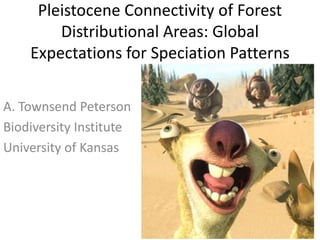
D2T3 exploring past distributions of species
- 1. Pleistocene Connectivity of Forest Distributional Areas: Global Expectations for Speciation Patterns A. Townsend Peterson Biodiversity Institute University of Kansas
- 4. Pleistocene Speciation • Largely discounted based on molecular clock results, most looking to pre-Pleistocene conditions • Refugium thinking … “retreated to refugium during glacial periods” … dominates • Evidence solely from molecular data streams … little or none from independent sources
- 5. AMAZON BASIN TEST REGION
- 7. Haffer’s Refugia? Potential Distribution 21,000 Years Ago Forest: All Species Hadley and Canadian Haffer’s Refugia
- 9. Present Models and LGM Projections
- 10. Test Phylogroup Consistency with Refugia
- 13. MIROC model
- 14. Test Phylogroup-Refugium Coincidence • Goals – seeking consistency of phylogroup distribution with LGM Pleistocene refugia • Assumption – Populations did not undergo broad shifts … i.e., the lineage of a point falling in a LGM refugium was there at LGM • Method – Identify refugia (e.g., disjunct areas at a threshold 10 of 10 models predicting in a GARP model) – Overlay points from which molecular sequence data (i.e., of known phylogroup) were obtained on refugia – Ignore points falling outside of refugia (they represent hypothesized dispersal events!) – Calculate observed degree of coincidence of refugia and phylogroup (i.e., how many times do points belonging to the same phylogroup fall in the same refugium?) – Calculate degrees of coincidence of ‘refugia’ and phylogroup for 100 randomized replicates … – Compare observed coincidence with randomized distribution of coincidences to establish probability values for observed degree of coincidence
- 15. Test Phylogroup Consistency with Refugia I MIROC
- 16. Test Phylogroup Consistency with Refugia II Threshold 10
- 17. Test Phylogroup Consistency with Refugia III Threshold applied
- 18. Test Phylogroup Consistency with Refugia IV Identify refugia by connectivity
- 19. Test Phylogroup Consistency with Refugia Overlay phylogroup-specified points
- 21. Amazon Basin – More Detail • 20 lineages co-distributed across the Amazon Basin • Detailed phylogeographic studies with nuclear and mitochondrial genes sequenced • Detailed paleo-distributional projections based on ecological niche models • Seeking common patterns across multiple taxa
- 24. Thamnophilus aethiops LGM / MIROC
- 25. Thamnophilus aethiops LGM / CCSM
- 27. Amazon Conclusions • General coincidence between expectations based on Pleistocene climate and distributional and phylogeographic patterns in bird species • Haffer may have been right in that climate drove isolation in the Amazon during the Pleistocene • However, considerable complexity in how processes were manifested across the region • Southeastern part so drastically affected as to extinguish populations
- 28. COOL AND WARM PERIODS AFFECT DIFFERENT REGIONS DIFFERENTLY
- 29. Study Design • Forest bird species only • 9 world regions • Develop models under present conditions • Test model predictions rigorously in present • Project to LGM (20K yr ago) and LIG (135K yr ago) • Assess fragmentation of populations in each time period
- 31. Tangara mexicana
- 33. Aburria aburri
- 34. Ducula carola
- 35. Now LGM LIG Fragmentation and Speciation Phase Andes E Africa Philippines Andes E Africa Philippines N America Amazon W Africa Madagascar
- 37. Results – Species-based Pleistocene History • Species in some regions fragmented in warm periods, others in cool periods • Adjacent regions can be in contrasting phases (e.g., Andes versus Amazon) • Speciation in Pliocene was probably not driven by climatic factors … • OR time estimates of speciation events are inaccurate (dramatically)
- 40. Fig 2. The top row (Current) is the predicted range for each species under contemporary climate patterns. The middle row (LGM) predicts the distribution for each taxa under two climate scenarios (CCSM3, MIROC), agreement between models is shown with darker colors and areas predicted by only one climate scenario are lighter. The bottom row depicts the predicted distribution for taxa at the last inter-glacial (LIG).
- 43. Conclusions and Next Steps • Potential for new insights by taking into account species’ ecological requirements and how their spatial footprints evolve through time • Speciation opportunity is out of phase in different regions • Pliocene speciation should not be an automatic conclusion from molecular clock-based inferences • Continents differ consistently and significantly in climate stability through time • Need to incorporate more and richer temporal data sets … in particular, Pliocene data (3.5M yr ago, HadCM3) and other ‘older’ data sets • Need to understand the effects of repeated cycles of fragmentation and connection on speciation
- 44. TOWN@KU.EDU
